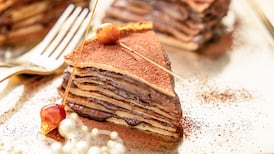Ingredients
- Serves 1
- ½ cup finely grated Pecorino Romano, plus some extra for garnish.
- 75-100g spaghetti or linguine
- 1 tsp freshly ground black pepper
It’s getting to that stage in the semester where those once far away deadlines are very much closer.
It’s also cold inside and outside, so keeping this mind, prepare to make a dish that consists of mostly cheese. Isn’t that what college is all about?
‘Cacio e Pepe’ is a Roman pasta dish made with Pecorino Romano cheese and black pepper, translated, it means “cheese and pepper”.
Pecorino is like a sharper and saltier version of parmesan. The sauce is made from tossing the cooked pasta with grated pecorino and black pepper. The grated pecorino emulsifies with the starchy pasta water and binds around the pasta, turning into a creamy sauce.
You can make Cacio e Pepe in two different ways; the traditional method, where you toss it all together, as outlined above, or the version I find a bit easier is where, right before the pasta is cooked, you make a paste out of the grated pecorino, black pepper and some pasta water first. This way, it’s ready to go and you just stir in the pasta.
The hardest part about this recipe is buying the pecorino, it might not be in every shop but you’ll find it in shops like Dunnes and posh food shops.
It’s important to grate the cheese finely and have it at room temperature before you begin cooking so that it melts into the sauce properly. Usually, you would add salt to pasta water to season the pasta but as pecorino is quite salty, so there’s no need to. This should take around 15 minutes to make.
1. Bring a pot of water to the boil and drop in the pasta. Use the time on the packet as a guideline.
2. In a large bowl (or saucepan, if you don’t have a bowl big enough), mix the grated pecorino and black pepper together.
3. Take about half a cup of pasta water from the pot and let it cool for a minute.
4. Add in some of the liquid to the pecorino and mix until it forms a paste, adding more liquid if needed.
Once the pasta is al dente, drain and add to the pecorino mix. Using a wooden spoon, tongs or whatever utensil is still working at this point of the semester to stir the pasta briskly with the sauce. If it’s a bit thick, add a bit more water until the sauce coats the pasta.
Serve in a bowl with some more pecorino on top if you like.










